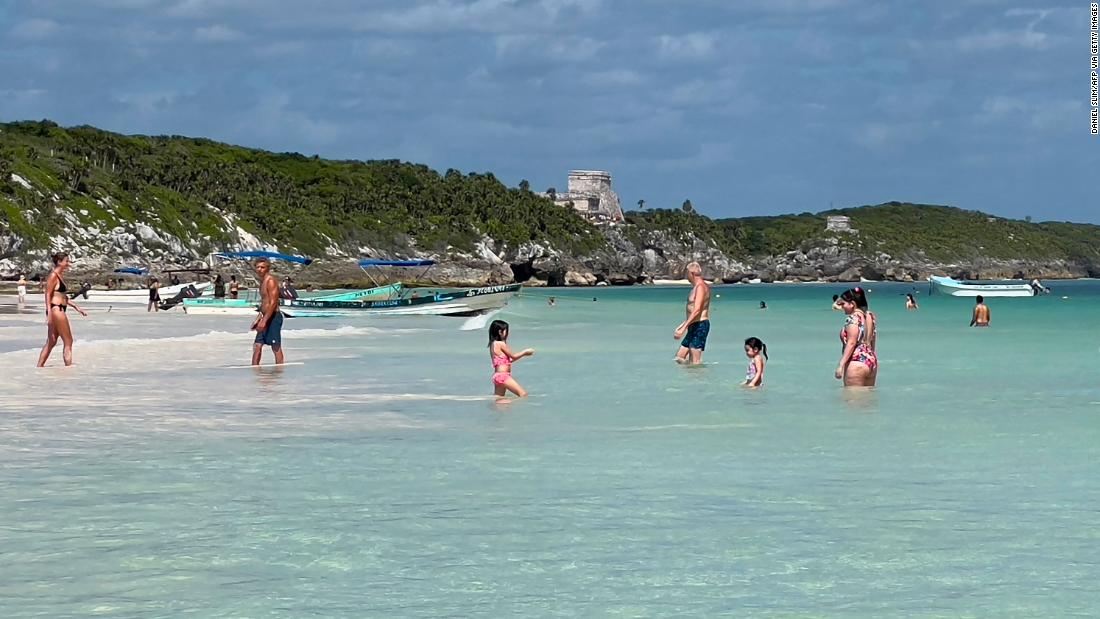
(CNN) — The US Centers for Disease Control and Prevention lowered the Covid-19 travel risk for one of the most popular destinations in the Western Hemisphere on Monday.
Mexico was moved down a level on the CDC’s scale from “high” risk to “moderate” risk on May 2, along with four other places around the world.
There wasn’t much movement overall on Monday on the CDC’s advisories list, though a major center of Middle Eastern tourism, Egypt, was placed in the “unknown” risk category. The CDC puts a destination there when it did not receive enough data in the past seven days to make an assessment.
The CDC recently overhauled its ratings system.
The Level 3 “high” risk category is now the top rung in terms of risk level. Level 2 is considered “moderate” risk, and Level 1 is “low” risk.
Level 4 is now reserved only for special circumstances. Under the new system, no destinations have been placed at Level 4 so far.
Level 3

Pedestrians cross the Champs-Élysées in front of the Arc de Triomphe monument in Paris on April 29, 2022. France is at Level 3, or “high” risk for Covid-19.
-/AFP/AFP via Getty Images
In the CDC’s new system, the Level 3 “high” risk category applies to destinations that have had more than 100 cases per 100,000 residents in the past 28 days.
Mexico was moved out of this category, and there were no new additions to Level 3 on May 2. However, much of Europe is still lodged there with the summer travel season getting ever closer.
On May 2, some popular European nations still at Level 3 included:
• France
• Germany
• Greece
• Ireland
• Italy
• The Netherlands
• Portugal
• Spain
• United Kingdom
It’s not just European favorites that find themselves at Level 3. Other popular travel spots around the world at high risk include:
• Brazil
• Canada
• Costa Rica
• Malaysia
• South Korea
• Thailand
There are more than 110 destinations at Level 3 this week. Level 3 locations account for almost half of the roughly 235 places monitored by the CDC.
Level 2
Destinations carrying the “Level 2: Covid-19 Moderate” designation reported 50 to 100 Covid-19 cases per 100,000 residents in the past 28 days. Five destinations were moved to this level on Monday. They are:
• Antigua and Barbuda
• Belize
• Mexico
• Taiwan
• Iran
The move wasn’t good news for Taiwan, which has been one of the bright spots throughout much of the pandemic. It had been at Level 1.
The move was good news for the other four places on this list, which had been Level 3.
Level 1
To be in “Level 1: Covid-19 Low,” a destination must have 49 or fewer new cases per 100,000 residents over the past 28 days. Just two destinations were added on May 2:
• Botswana
• Indonesia
Botswana, an emerging favorite for people on safaris, had been unknown. Indonesia previously was at Level 2.
This level is dominated by destinations in Africa, including Kenya, Rwanda and Senegal. Level 1 had about 55 entries total this week.
Unknown

Tourists visit the Temple of Hatshepsut in Luxor on April 26, 2022. Egypt was placed into the “unknown” risk category on Monday.
Sui Xiankai/Xinhua/Getty Images
Finally, there are destinations for which the CDC has an “unknown” risk because of a lack of information. Usually, but not always, these are small, remote places or places with ongoing warfare or unrest. The three additions on Monday to this category are:
• Egypt
• Guinea
• Paraguay
All three had been at Level 3.
The CDC advises against travel to these places precisely because the risks are unknown. Also attracting their fair share of visitors in this category are the Azores, Cambodia and Nicaragua.
A medical expert weighs in on risk levels
Transmission rates are “one guidepost” for travelers’ personal risk calculations, according to CNN Medical Analyst Dr. Leana Wen.
We’ve moved into “a phase in the pandemic where people need to make their own decisions based on their medical circumstances as well as their risk tolerance when it comes to contracting Covid-19,” said Wen, who is an emergency physician and professor of health policy and management at the George Washington University Milken Institute School of Public Health.
There are other factors to weigh in addition to transmission rates, according to Wen.
“Another is what precautions are required and followed in the place that you’re going and then the third is what are you planning to do once you’re there.
“Are you planning to visit a lot of attractions and go to indoor bars? That’s very different from you’re going somewhere where you’re planning to lie on the beach all day and not interact with anyone else. That’s very different. Those are very different levels of risk.”
Vaccination is the most significant safety factor for travel since unvaccinated travelers are more likely to become ill and transmit Covid-19 to others, Wen said.
And it’s also important to consider what you would do if you end up testing positive away from home. Where will you stay and how easy will it be to get a test to return home?
Top image: A beach in Tulum, Mexico, is pictured in October 2021. (Photo by Daniel Slim/AFP via Getty Images)